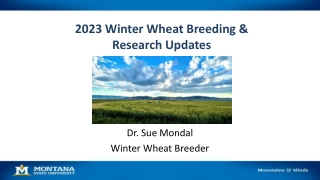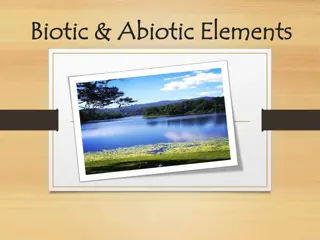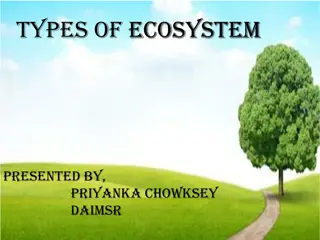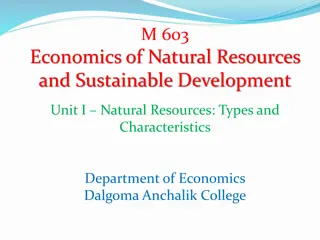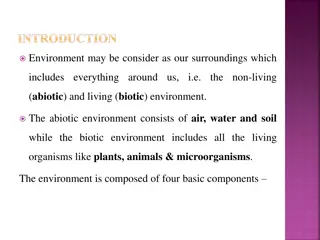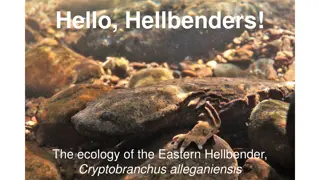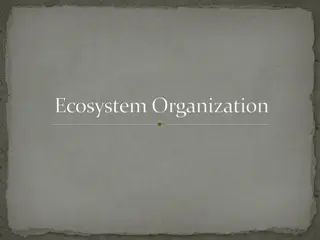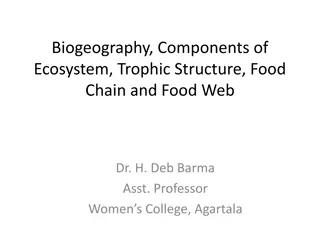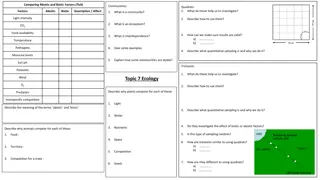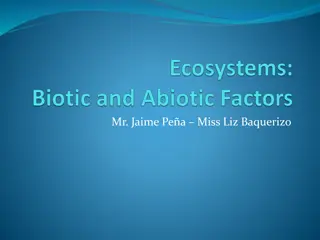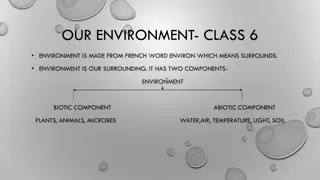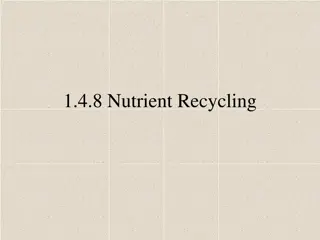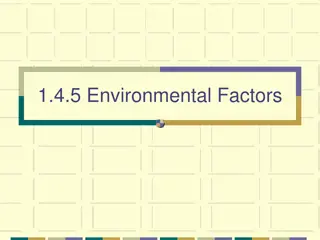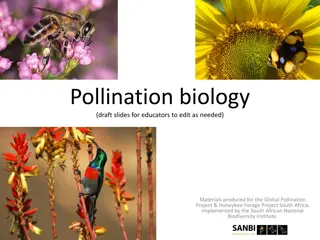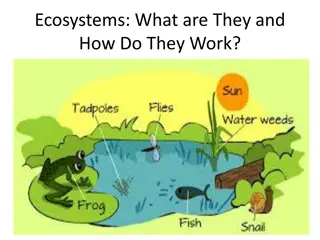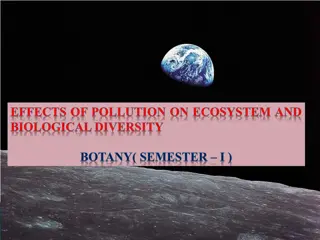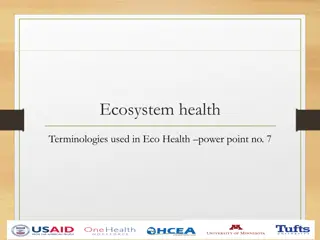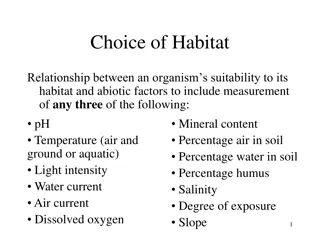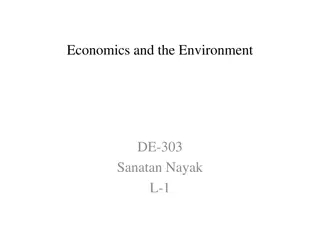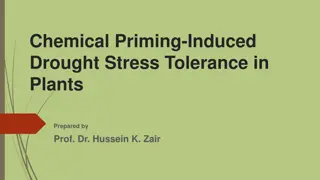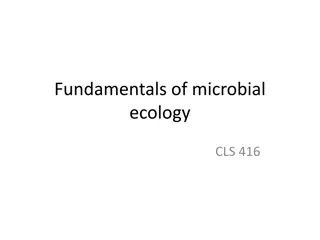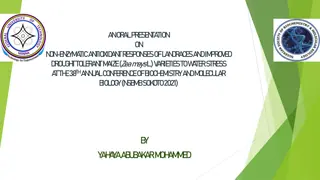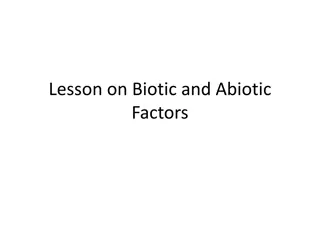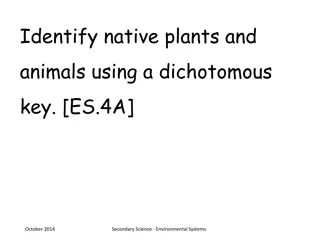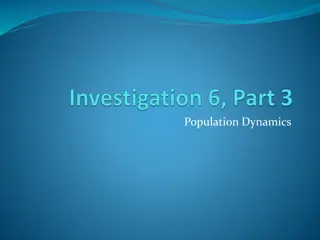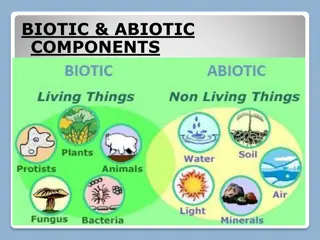2023 Winter Wheat Breeding & Research Updates
Get the latest updates on winter wheat breeding and research from Dr. Sue Mondal, a winter wheat breeder. Explore topics such as abiotic stress tolerance, genomic technologies, rapid cycling, disease resistance, and more.
3 views • 21 slides
Understanding Ecology: Interactions Between Organisms and their Environment
Ecology is the scientific study of how living organisms interact with each other and their environment. It delves into the relationships between biotic and abiotic factors, encompassing topics such as the distribution and abundance of organisms, structural adaptations, behavior under natural conditi
2 views • 42 slides
Field Study Techniques for Environmental Monitoring
Explore various field study techniques for monitoring environmental factors such as biotic and abiotic elements, canopy cover, humidity, light intensity, and wind direction and speed. Learn how to measure and interpret these parameters effectively using tools like hygrometers, lux meters, compasses,
3 views • 18 slides
Exploring Different Ecosystem Types and Functions
Learn about the major types of ecosystems such as Grassland, Aquatic, Forest, and Desert presented by Priyanka Chowksey of DAIMSR. Understand the components of an ecosystem, including biotic and abiotic factors, and the significance of different ecosystems like Forest Ecosystem and Desert Ecosystem.
4 views • 29 slides
Understanding Environmental Stress and Plant Management
Environmental stress, whether biotic or abiotic, can adversely affect plant growth and yield. Factors such as temperature extremes, waterlogging, radiation, chemicals, and pollution can lead to plant strains that may be reversible or permanent. Effective management of stress due to excessive moistur
8 views • 35 slides
Understanding Natural Resources and Resource Economics
Economics of natural resources focuses on the supply, demand, and sustainable allocation of the Earth's resources. It aims to develop a sustainable economy that protects natural resources for future generations. Natural resources are essential for human survival and include biotic and abiotic resour
0 views • 11 slides
Factors Affecting Global Distribution of Plants and Animals
The distribution of plants and animals worldwide is influenced by abiotic and biotic factors. Factors such as rocks, food availability, air quality, water supply, and soil type play crucial roles in determining where species thrive. From the availability of nutrients like nitrogen and phosphorus to
0 views • 8 slides
Understanding the Components and Types of Environmental Pollution
The environment comprises abiotic and biotic elements, including the atmosphere, hydrosphere, lithosphere, and biosphere. Different types of pollution, such as air, water, land/soil, noise, and thermal pollution, pose significant threats to human health and the environment. Awareness of these pollut
1 views • 17 slides
Understanding the Ecology of Eastern Hellbenders
This comprehensive guide explores the ecology of Eastern Hellbenders (Cryptobranchus alleganiensis), discussing the abiotic and biotic factors influencing these fascinating salamanders. Covering topics such as populations, communities, and the essential role of producers, it sheds light on the chall
2 views • 16 slides
Understanding Ecosystem Organization and Hierarchy
Explore the intricate relationships within ecosystems through the study of organization and hierarchy. From individual organisms to complex communities, learn how biotic and abiotic factors shape these environments. Gain insights into the levels of ecosystem organization, from single organisms to in
5 views • 15 slides
Exploring the Major Types of Ecosystems
Explore the diverse world of ecosystems, including grassland, aquatic, forest, and desert ecosystems. Learn about the biotic and abiotic factors that shape these environments and the critical roles they play in supporting life. Delve into forest ecosystems with their canopy, floor, and soil features
0 views • 29 slides
Understanding Biogeography, Ecosystem Components, Trophic Structure, Food Chain, and Food Web
Biogeography delves into the origin, distribution, and adaptations of plants and animals, aiding in earth surface differentiation. Ecosystems involve interactions between biotic and abiotic elements, forming trophic structures, biodiversity, and material cycles. Learn about the concepts, definitions
0 views • 29 slides
Exploring Abiotic and Biotic Factors in Communities
Investigating abiotic and biotic factors in communities through quadrats helps study interactions like light intensity, CO2 levels, food availability, and more. It ensures validity by considering interdependence, competition, and sampling techniques like transects. Examining adaptations in animals a
1 views • 4 slides
Exploring Ecosystems and Living Interactions
Dive into the world of ecosystems, learning about biotic and abiotic factors, relationships between living things, and the impact of temperature changes. Understand the essential elements that determine life in an ecosystem and the interconnectedness of all living organisms.
0 views • 7 slides
Understanding Our Environment: Class 6 Overview
The environment, derived from the French word "environ" meaning surrounds, encompasses both biotic (living) and abiotic (non-living) components. Biotic components include plants, animals, and microbes, while abiotic components consist of water, air, temperature, light, and soil. Plants are producers
1 views • 9 slides
Nutrient Recycling in Ecosystems
Nutrient recycling in ecosystems involves the continuous breakdown and exchange of elements between living and non-living components, ensuring sustainability and no long-term drain on Earth's nutrients. This process includes decomposition of organic material by bacteria and fungi, uptake of nutrient
1 views • 23 slides
Understanding Environmental Factors in Terrestrial and Aquatic Environments
Environmental factors play a crucial role in shaping ecosystems. In both terrestrial (land) and aquatic (water) environments, organisms are influenced by abiotic factors such as temperature, light intensity, and pH, as well as biotic factors like plants, predators, and competitors. Understanding the
4 views • 19 slides
Understanding Pollination Biology and the Importance of Honeybees
Pollination is a crucial process for plant reproduction, with both abiotic and biotic methods. Self- and cross-pollination play essential roles, relying on various agents like insects. Honeybees, vital pollinators, have a significant impact on food production and ecosystem balance, demonstrating the
0 views • 18 slides
Understanding Ecological Niches in Advanced Biology
In Advanced Higher Biology, the concept of ecological niches is explored in depth, considering both abiotic and biotic factors that impact an organism's role in its environment. The fundamental and realized niches are distinguished, along with the Competitive Exclusion Principle and examples like sq
4 views • 18 slides
Understanding Plant Stress and Management of Excessive Moisture
Environmental stress, both biotic and abiotic, can negatively impact plant growth. Factors like temperature, water, radiation, chemicals, pollution, and more can lead to strain in plants, affecting their development. Excessive moisture, particularly waterlogging, is a significant stressor that can r
0 views • 35 slides
Understanding Ecosystems: Structure, Components, and Functions
Ecosystems are intricate units where living organisms interact with each other and the environment. They consist of biotic (living) and abiotic (non-living) components, interrelated in a chain of interactions. Biotic components include autotrophs, heterotrophs, and decomposers, while abiotic compone
0 views • 15 slides
Understanding Ecosystems: A Beginner's Guide to Ecology
Explore the fascinating world of ecosystems with Mrs. Hart in this informative biology lesson. Discover the components of ecosystems, from biotic to abiotic factors. Learn how energy flows through the ecosystem, with autotrophs producing energy and heterotrophs consuming it. Identify different types
0 views • 33 slides
Understanding Ecosystems: Components and Interactions
Ecosystems are dynamic systems where abiotic and biotic components interact to sustain life. Ecology studies these interactions, including nutrient cycling and energy flow. The biosphere, comprising the atmosphere, hydrosphere, lithosphere, and living organisms, forms Earth's life-support system. Ec
0 views • 22 slides
Understanding Ecology: Interactions in Ecosystems
Explore the intricate web of interactions in ecosystems through the study of ecology. Learn how biotic and abiotic factors shape ecosystems, trace energy flow, and understand nutrient cycles. Discover the importance of biodiversity and the impact of human activities on the biosphere. Dive into topic
0 views • 51 slides
Understanding Ecosystems: A Comprehensive Guide
An ecosystem comprises both living (biotic) and non-living (abiotic) factors interacting in a specific area, with populations, communities, and ecology playing essential roles. Abiotic factors like temperature, water, sunlight, and wind influence species distribution, while biomes categorize ecosyst
1 views • 23 slides
Understanding Ecosystems: Definition, Structure, and Function
Ecosystems consist of living and non-living parts forming stable systems. They involve energy flow, nutrient cycling, and interactions between organisms and their environment. Ecosystems vary in abiotic and biotic conditions, with producers, consumers, and decomposers playing key roles. Changes in t
0 views • 13 slides
Understanding Biological Diversity and Ecological Organization
Exploring the intricate balance of flora and fauna on our planet, this content delves into the vast array of plant and animal species coexisting in various ecosystems. It discusses the significance of biodiversity, the interaction of biotic and abiotic components in ecological systems, and the ecolo
0 views • 41 slides
Understanding EcoHealth: Terminologies and Concepts
Ecosystem health and EcoHealth explore the interconnectedness of humans, animals, and ecosystems. Concepts like One Health emphasize collaboration for optimal health across species. Terms like abiotic, biotic, habitat, and biodiversity are key in understanding ecosystems and their health. Symbiosis
0 views • 8 slides
Understanding Environmental Hazards and Management
Exploring major hazards management, geology perspectives, ecological concepts, natural environmental hazards, classes of natural hazards, and introduction to environmental hazards management. The content covers ecological levels, abiotic factors, biomes, environmental degradation, and more.
0 views • 10 slides
Understanding Organism Habitat Suitability Through Abiotic Factors
Explore the relationship between organisms and their habitats based on abiotic factors like pH, temperature, light intensity, and more. Learn how to measure and relate these factors to the organisms' choice of habitat, with practical investigation procedures and result analysis provided.
0 views • 59 slides
Understanding the Intersection of Economics and the Environment
Environment comprises all elements, both living and non-living, that encompass an organism, including humans. This includes the natural environment, which encompasses all biotic and abiotic components around us. Understanding the economic implications of environmental factors is crucial for sustaina
0 views • 281 slides
Understanding Chemical Priming for Drought Stress Tolerance in Plants
Major agricultural industries struggle with abiotic stresses like drought, which can lead to crop losses. Nutrient limitations and cellular damage further compound the challenges plants face under water-limited conditions. Despite efforts in plant breeding, improving germplasm for drought tolerance
0 views • 72 slides
Understanding Microbial Ecology and Ecosystem Components
Study the diverse relationships of living organisms in their environment, focusing on microbial ecology, ecosystem components, and evolutionary adaptations. Explore the dynamics of abiotic and biotic factors, including producers, decomposers, and consumers, and the types of interactions shaping popu
1 views • 7 slides
Non-enzymatic Antioxidant Responses of Maize Varieties to Water Stress
Introduction of maize as a crucial crop facing challenges from both biotic and abiotic factors like drought, leading to oxidative stress. Non-enzymatic antioxidants play a key role in combating reactive oxygen species (ROS) caused by drought, with crop landraces showing potential in stress adaptatio
0 views • 19 slides
Exploring Biotic and Abiotic Factors in Ecosystems
This lesson delves into the importance of biotic and abiotic factors in ecological systems. Students will learn to differentiate between living (biotic) and non-living (abiotic) components affecting organisms such as mice and plants. Through engaging activities and challenges, participants will gras
0 views • 21 slides
Understanding Ecology: Key Concepts and Types Explained
Ecology, a vital branch of science, delves into the relationships between organisms and their environment. It encompasses biotic and abiotic factors, studying how living and non-living elements interact within ecosystems. Biotic components include living organisms like plants and animals, while abio
0 views • 7 slides
Exploring Ecosystem Dynamics: Environmental Systems Study
In this Environmental Systems study, students delve into identifying native plants and animals using a dichotomous key, assessing their roles within local ecosystems, and comparing them to other biomes. They also analyze abiotic cycles such as rock, hydrologic, carbon, and nitrogen cycles, and evalu
0 views • 40 slides
Understanding Population Dynamics in Ecosystems
Exploring the concept of carrying capacity, examining real data from Mono Lake, comparing predictions to actual data, discussing biotic and abiotic limiting factors, and understanding how organisms can impact populations without direct predation. Dynamic ecosystems are constantly changing, as eviden
0 views • 13 slides
Understanding Abiotic Cycles in Ecosystems: Hydrologic, Carbon, Nitrogen, and More
Abiotic cycles play a crucial role in regulating ecosystems. The hydrologic cycle involves processes like evaporation, condensation, precipitation, and transpiration. The carbon cycle relies on photosynthesis, respiration, and human activities like deforestation and burning fossil fuels. The nitroge
0 views • 20 slides
Understanding Biotic and Abiotic Components in Ecosystems
Explore the relationship between biotic (living) and abiotic (non-living) components in ecosystems. Learn about the roles of plants, animals, decomposers, and scavengers. Discover the importance of biodegradable and non-biodegradable materials in the environment.
0 views • 21 slides
